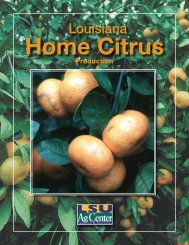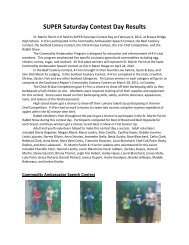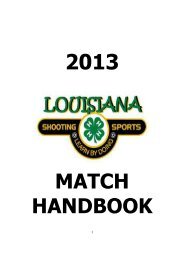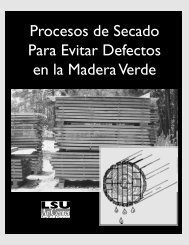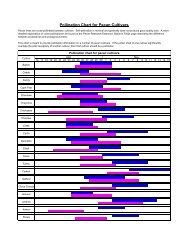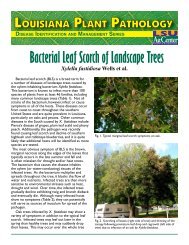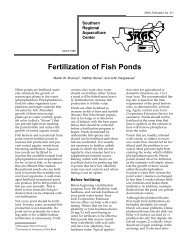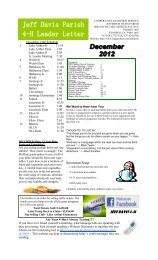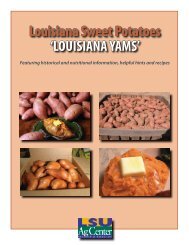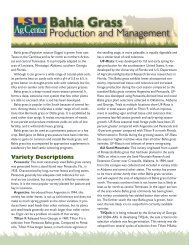Cocahoe Minnow - The LSU AgCenter
Cocahoe Minnow - The LSU AgCenter
Cocahoe Minnow - The LSU AgCenter
Create successful ePaper yourself
Turn your PDF publications into a flip-book with our unique Google optimized e-Paper software.
Chapter 13. Economic Analysis<br />
Undertaking a large project such as baitfish farming<br />
requires a good deal of advanced planning to ensure<br />
that prudent decisions are made. <strong>The</strong> purpose of<br />
this section is to provide cost estimates for potential<br />
producers. <strong>The</strong>se estimates may assist interested parties<br />
in deciding which type of production, if any, is right for<br />
their individual situation. However, projected costs and<br />
returns vary considerably based on available resources<br />
and scale. <strong>The</strong>se cost projections are meant to act as<br />
a guideline only for interested parties and potential<br />
producers to make cost estimates appropriate to their<br />
unique situations. Every individual situation will be<br />
unique and cannot be duplicated here.<br />
In order to gain an accurate economic portrayal,<br />
interviews were conducted at four Louisiana bait shops<br />
across three parishes. <strong>The</strong>se interviews served to provide<br />
information on interactions between wholesalers<br />
and retailers. Shop owners and managers were asked<br />
questions regarding holding capacity, types of holding<br />
systems, sale price, and survivability of cocahoe<br />
minnows. <strong>The</strong>y also provided data on wholesale prices,<br />
reliability of wholesalers, and turnover on minnow<br />
batches. All of the shops interviewed sold cocahoe<br />
minnows as live bait. Of the four shops interviewed,<br />
three received their minnows from external harvesters.<br />
One of the shops interviewed caught their own bait.<br />
This shop also provided valuable information on<br />
the costs associated with catching minnows. <strong>The</strong><br />
information collected in these interviews was used to<br />
determine our estimated standard price per minnow as<br />
well as the volume of minnows that could be sold per<br />
average unit of time. For the purpose of our estimates,<br />
both the average wholesale price and the average weekly<br />
turnover were used.<br />
Five owner-operator production examples were<br />
developed, and costs associated with each were<br />
identified and quantified. An economic model was<br />
developed to create the projected costs and returns for<br />
each example. Projected costs for production scenarios<br />
were the result of a combination of information<br />
obtained from past minnow production publications,<br />
research and operations taking place at the <strong>LSU</strong><br />
<strong>AgCenter</strong> Aquaculture Research Station, and the bait<br />
24<br />
shop interviews. For these examples, it was assumed<br />
that the owner-operator was already in possession of<br />
the land needed with some type of existing structure for<br />
the production system. Prices of materials were based<br />
on average market value as of spring 2012. <strong>The</strong> costs<br />
and returns associated with these models are dependent<br />
on a number of factors. <strong>The</strong> type of production system<br />
employed and the size or scale of the operation have<br />
significant impacts on both the total investment needed<br />
and the estimated return as seen in our examples. <strong>The</strong><br />
location of the operation may also influence costs.<br />
<strong>The</strong>se numbers are based on hypothetical examples, and<br />
actual costs and returns will vary based on individual<br />
situations. All scenarios are assuming a price of $0.15<br />
Owner-Operator Production Scenarios:<br />
1) Wild Harvest and Immediate Sale<br />
<strong>Minnow</strong>s are trapped in the wild and sold<br />
immediately after harvest to bait shops or the<br />
public.<br />
2) Wild Harvest and Long Term Holding<br />
<strong>Minnow</strong>s are trapped in the wild with the majority<br />
of the catch sold immediately after harvest to bait<br />
shops or the public. In this scenario extra traps<br />
are fished and a portion of the catch is held over<br />
to be sold in the off season when fish are not as<br />
abundant.<br />
3) Intensive Recirculated System<br />
<strong>Minnow</strong>s are produced from eggs solely in tanks<br />
or pools in a closed recirculated system where all<br />
nutrition is provided via prepared feed.<br />
4) Pond Only Production System<br />
<strong>Minnow</strong>s are produced from eggs solely in ponds<br />
where nutrition comes primarily from natural<br />
productivity and supplemented with prepared feed.<br />
5) Pool Spawning and Pond Growout<br />
Production System<br />
A hybrid system where minnows are produced<br />
from eggs. Broodfish are spawned intensively in<br />
pools. Larvae are hatched in outdoor ponds where<br />
nutrition comes primarily from natural productivity<br />
and supplemented with prepared feed.




